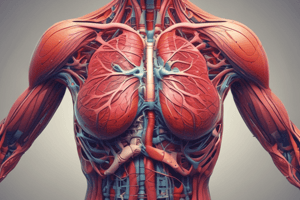Podcast
Questions and Answers
Which system consists of bones, joints, ligaments, and cartilages?
Which system consists of bones, joints, ligaments, and cartilages?
- Skeletal System (correct)
- Circulatory System
- Respiratory System
- Endocrine System
What is the primary function of the nervous system?
What is the primary function of the nervous system?
- Production of blood cells
- Support and protection
- Control and coordination of body activities (correct)
- Transportation of oxygen
Which part of the circulatory system carries oxygen, nutrients, and hormones to the cells of the body?
Which part of the circulatory system carries oxygen, nutrients, and hormones to the cells of the body?
- Heart
- Spinal Cord
- Blood Vessels (correct)
- Cartilages
Which system is subdivided into the central nervous system and peripheral nervous system?
Which system is subdivided into the central nervous system and peripheral nervous system?
What is the function of the heart in the circulatory system?
What is the function of the heart in the circulatory system?
Which system extends through the vertebral column?
Which system extends through the vertebral column?
Which system is responsible for regulating the body's internal environment and maintaining homeostasis?
Which system is responsible for regulating the body's internal environment and maintaining homeostasis?
What is the primary function of the respiratory system?
What is the primary function of the respiratory system?
Which gland is NOT considered a major endocrine gland?
Which gland is NOT considered a major endocrine gland?
How do medicines primarily work in the human body?
How do medicines primarily work in the human body?
Which organ is NOT part of the respiratory system?
Which organ is NOT part of the respiratory system?
What is the main function of the circulatory system?
What is the main function of the circulatory system?
Flashcards are hidden until you start studying
Study Notes
Anatomy and Physiology: An Overview of the Human Systems
Skeletal System
The human skeletal system consists of bones, joints, ligaments, and cartilages. Bones provide support and protection for the body, and they also serve as sites for the production of blood cells. The skeletal system is subdivided into axial and appendicular skeletons. The axial skeleton includes the skull, spine, and thorax. The appendicular skeleton includes the bones of the upper and lower limbs, the pectoral and pelvic girdles, and the clavicle.
Nervous System
The nervous system is responsible for controlling and coordinating the body's activities. It consists of the brain, spinal cord, and peripheral nerves. The brain receives information from the body's environment and generates instructions, while the spinal cord extends through the vertebral column. The nervous system is divided into the central nervous system (CNS) and the peripheral nervous system (PNS).
Circulatory System
The human circulatory system, also known as the cardiovascular system, is responsible for transporting oxygen, nutrients, and hormones throughout the body. It consists of the heart, blood vessels, and blood. The heart pumps blood through the blood vessels, which include arteries, veins, and capillaries. Blood carries oxygen, nutrients, and hormones to the cells of the body, and it also carries waste products back to the organs of excretion.
Endocrine System
The endocrine system is responsible for regulating the body's internal environment and maintaining homeostasis. It consists of endocrine glands, which produce hormones that regulate various physiological processes. The major endocrine glands include the pituitary, thyroid, parathyroid, adrenal, pancreas, and gonads.
Respiratory System
The respiratory system is responsible for the exchange of oxygen and carbon dioxide between the body and the external environment. It consists of the nose, pharynx, larynx, trachea, bronchi, bronchioles, alveoli, and the diaphragm. The respiratory system also plays a role in the regulation of blood pressure and pH levels.
Medicines
Medicines, also known as pharmaceuticals or drugs, are substances that are used to treat, cure, or alleviate symptoms of various diseases and health conditions. They can be administered through various routes, such as oral, intravenous, subcutaneous, topical, or inhalation. Medicines work by interacting with specific targets in the body, such as proteins, enzymes, or receptors, to produce a therapeutic effect.
The human body is a complex system of interconnected organ systems, each with its unique functions and responsibilities. Understanding these systems and their interrelationships is crucial for maintaining good health and treating diseases.
Studying That Suits You
Use AI to generate personalized quizzes and flashcards to suit your learning preferences.




